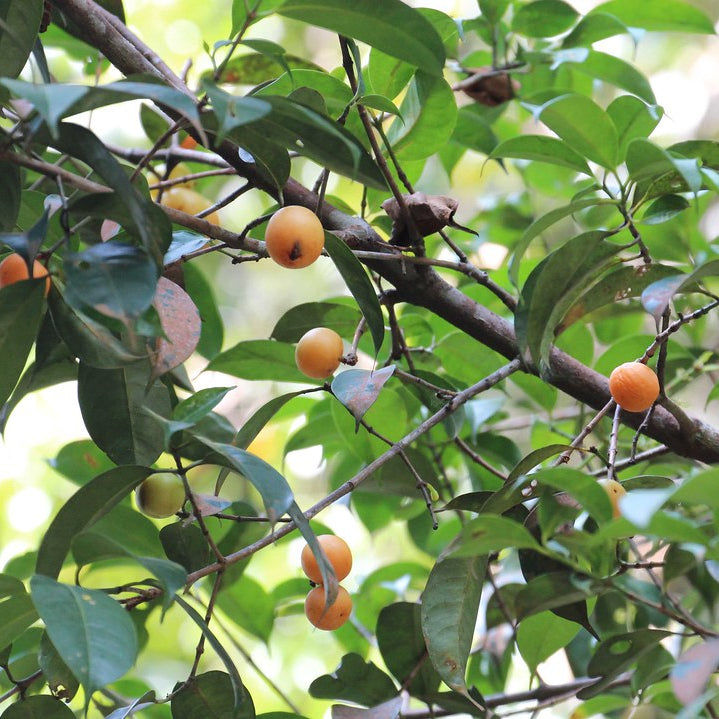Love it? Add to your wishlist
Your favorites, all in one place. Shop quickly and easily with the wishlist feature!
[message]
[title]
[message]



Veliyath Gardens
Couldn't load pickup availability
Botanical Name: Garcinia parvifolia
Common Names: Asam Kandis, Kundong, Brunei Cherry, Asam Aur Aur
Native Regions: Malaysia, Brunei, Borneo, parts of Indonesia
This lesser-known but highly cherished evergreen fruit tree is a true native of Southeast Asia's lush landscapes. Often gathered from the wild in Brunei and Borneo, and occasionally grown in home gardens, Asam Kandis offers much more than just its looks. With its cherry-sized, golden-yellow fruits and delightfully sour-sweet pulp, this plant is a hidden gem for exotic fruit lovers.
Due to growing awareness of its value, Veliyath Gardens experiences high demand for this plant, and availability is currently limited.
Tree Height: Typically small to medium-sized, manageable in home gardens
Fruiting Period: Begins 3–4 years after planting
Fruit Size and Color: Small, cherry-like, ripening to yellow
Pulp: White, juicy, tender, with a pleasing sour tang
Seeds: Small, embedded in the soft pulp
This tree makes for a stunning addition to any tropical garden, blending ornamental beauty with edible function.
Asam Kandis is known for its sweet-tart, citrus-like profile that delights culinary explorers. The fresh pulp delivers a refreshing punch of flavor, while the dried rind and young fruits serve more intense, concentrated sour notes:
Taste Profile:
Sour with subtle sweetness
Tangy with refreshing acidity
Slight floral undertones
Culinary Uses Include:
Eaten Fresh: Enjoyed raw with dips like soy sauce and Spanish chili
Dried Fruit Wedges: Used in stews, sambals, or pickles
Dried Rind: A staple souring agent in traditional curries and fish preparations
Cooked Pulp: Incorporated into sauces and spicy relishes
Its ability to lift dishes with vibrant sourness has earned it an esteemed spot in Malay, Bruneian, and Bornean kitchens.
As with many species in the Garcinia genus, Asam Kandis is valued not only for its flavor but also its contribution to wellness:
Digestive Tonic: Aids in stimulating appetite and relieving indigestion
Natural Antioxidants: Contains beneficial compounds that reduce cellular oxidative stress
Liver Cleanser: Traditionally used in herbal decoctions for detoxification
Cooling Effect: Offers relief in tropical heat, often used in traditional cooling tonics
Anti-inflammatory Properties: Used in folk medicine to reduce swelling and inflammation
In Brunei and parts of Borneo, the fruit and bark are sometimes infused into teas or used in poultices as part of indigenous healing practices.
Though less researched compared to other Garcinia fruits, Asam Kandis is believed to be a source of:
Vitamin C – Helps boost immunity and aids in skin health
Hydroxycitric Acid (HCA) – A natural compound known for its fat-inhibiting properties
Dietary Fibre – Supports digestive function and satiety
Minerals – Trace amounts of potassium and calcium contribute to metabolic balance
Its inclusion in the daily diet, especially when consumed dried or infused in warm beverages, can contribute to a wholesome tropical food pattern.
There are many delightful ways to weave this exotic fruit into your lifestyle:
As a Curry Enhancer: Use the dried rind for a depth of flavor in coconut-based stews
Infused Water: Add a slice to warm or cold water for a cleansing sour drink
Fermented Chutneys: Blend the pulp with ginger and jaggery for a probiotic-rich preserve
Fruit Pairing: Serve fresh slices with salt and chili for a healthy snack
Plant-Based Sauces: Add to tamarind-based or tomato-based sauces for a natural sour edge
A practical choice for exotic fruit lovers, Asam Kandis offers both productivity and aesthetic charm.
Climate: Requires warm, tropical or subtropical climate
Sunlight: Full sun to partial shade
Soil: Thrives in loamy, well-drained soil with neutral pH
Watering: Regular watering is essential, especially in dry seasons
Fertilization: Organic compost twice a year for healthy flowering and fruiting
Pruning: Occasional shaping for better airflow and sunlight penetration
This is a moderate-maintenance plant that rewards patience with seasonal harvests and year-round greenery.
Fresh fruits are best consumed soon after harvesting. To extend the use:
Refrigeration: Keeps fresh fruit usable for up to 4–5 days
Sun-Drying: Young fruits can be sliced and dried for long-term storage
Dried Rind: Best stored in airtight containers away from moisture
Paste or Sauce: Homemade preserves can be kept for several weeks refrigerated
Dried slices and rinds retain flavor for months, allowing you to enjoy this fruit across seasons.
In Brunei and parts of Malaysia, Asam Kandis is more than food—it is a part of cultural memory:
Used in ceremonial dishes and special feasts
Given as a gift in the form of pickles or dried wedges
Associated with hospitality and the art of balanced cooking
Revered as a plant of both flavor and healing
The tree is also cherished by local healers and traditional cooks, often growing near homes as a practical, sacred, and living kitchen companion.
As interest in native and medicinal plants rises, Asam Kandis is seeing a quiet resurgence. However, it remains scarce in cultivation, and Veliyath Gardens receives frequent requests for this variety.
Because of limited propagation and seasonal availability, only a small number of healthy live plants are currently offered.
If you wish to bring home a plant that bridges tradition, taste, and tropical elegance, the Asam Kandis (Garcinia parvifolia) is waiting to root itself in your fruit garden.
Climate: Requires warm, tropical or subtropical climate
Sunlight: Full sun to partial shade
Soil: Thrives in loamy, well-drained soil with neutral pH
Watering: Regular watering is essential, especially in dry seasons
Vitamin C – Helps boost immunity and aids in skin health
Hydroxycitric Acid (HCA) – A natural compound known for its fat-inhibiting properties
Dietary Fibre – Supports digestive function and satiety
As a Curry Enhancer: Use the dried rind for a depth of flavor in coconut-based stews
Infused Water: Add a slice to warm or cold water for a cleansing sour drink
Fermented Chutneys: Blend the pulp with ginger and jaggery for a probiotic-rich preserve




